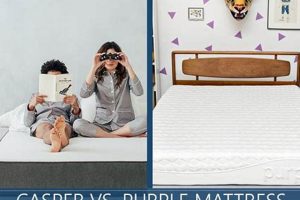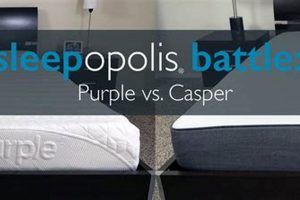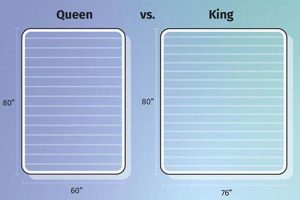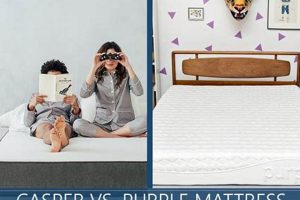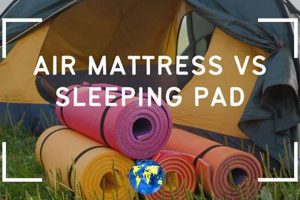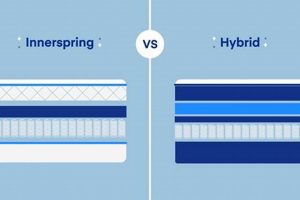A comparison of two popular mattress constructions, all-foam and hybrid, reveals fundamental differences in materials and design. All-foam mattresses typically utilize various densities and types of foam, such as memory foam and polyurethane foam, to provide support and comfort. Conversely, hybrid mattresses combine a core of innerspring coils with layers of foam, latex, or other materials on top.
The selection between these two types can significantly impact sleep quality due to variations in factors like temperature regulation, motion isolation, and support. All-foam models are often favored for their ability to conform to the body’s contours and minimize motion transfer. Hybrid models, however, may offer enhanced breathability and edge support, leading to a different sleep experience. Historically, innerspring mattresses were the standard, but the introduction of foam and hybrid designs has broadened consumer choice and addressed specific comfort preferences.
The following sections will delve into the specific characteristics of each mattress type, examining their construction, performance, and suitability for different sleep styles and needs. This analysis aims to provide a framework for understanding the advantages and disadvantages of each option, assisting individuals in making an informed decision based on their personal requirements.
Considerations for Choosing Between All-Foam and Hybrid Mattresses
Selecting the optimal mattress necessitates a thorough evaluation of individual sleep preferences and needs. Understanding the nuances of all-foam and hybrid construction is paramount for informed decision-making.
Tip 1: Assess Sleep Style: Side sleepers often benefit from the enhanced contouring offered by all-foam mattresses, which can alleviate pressure points on the hips and shoulders. Back and stomach sleepers may find the firmer support of hybrid mattresses more conducive to spinal alignment.
Tip 2: Evaluate Temperature Sensitivity: Individuals prone to overheating should prioritize mattresses with enhanced breathability. Hybrid models, with their coil core, generally allow for greater airflow compared to all-foam options. Gel-infused foam or open-cell foam technologies can mitigate heat retention in all-foam mattresses.
Tip 3: Determine Motion Isolation Needs: All-foam mattresses excel at absorbing motion, making them suitable for couples or individuals sharing a bed. Hybrid mattresses, particularly those with individually wrapped coils, can also provide good motion isolation, although typically to a lesser extent than all-foam.
Tip 4: Consider Edge Support Requirements: Hybrid mattresses typically offer superior edge support due to the reinforced perimeter coils. Strong edge support is beneficial for individuals who sleep near the edge of the bed or require assistance getting in and out of bed.
Tip 5: Evaluate Firmness Preferences: Both all-foam and hybrid mattresses are available in a range of firmness levels. Selecting the appropriate firmness is crucial for optimal comfort and spinal support. Consider trialing different firmness levels in-store before making a purchase.
Tip 6: Review Material Quality and Certifications: Opt for mattresses constructed with high-quality, durable materials. Look for certifications such as CertiPUR-US, which indicates that the foam has been tested for harmful substances and meets stringent emissions standards.
Tip 7: Investigate Warranty and Return Policies: A comprehensive warranty and a generous return policy provide peace of mind and allow for a trial period to assess the mattress’s suitability. Carefully review the terms and conditions of the warranty and return policy before purchasing.
In summary, the choice hinges on balancing comfort, support, temperature regulation, and motion isolation based on individual circumstances. Thorough research and testing are highly recommended.
The subsequent conclusion will synthesize the key differences and provide a final perspective on selecting the optimal mattress type.
1. Construction
Mattress construction fundamentally dictates its performance characteristics, creating a clear distinction between all-foam and hybrid designs. The core difference lies in the presence or absence of an innerspring coil system. All-foam mattresses rely entirely on various foam layers, such as memory foam, polyurethane foam, and high-density support foam, to provide support, comfort, and pressure relief. The density, type, and arrangement of these foam layers directly influence the mattress’s firmness, contouring ability, and temperature regulation properties. For example, a high-density memory foam top layer can enhance pressure relief, while a convoluted foam layer beneath it can improve airflow.
Hybrid mattresses, in contrast, integrate an innerspring coil system as the primary support core, topped with layers of foam, latex, or other materials. The coil system provides a responsive, bouncy feel and enhanced edge support compared to all-foam options. The type of coil system, such as pocketed coils or Bonnell coils, also impacts the mattress’s performance. Pocketed coils, for instance, offer superior motion isolation by allowing each coil to move independently. The combination of coils and comfort layers aims to balance support, comfort, and temperature regulation. The construction of the comfort layers also affects the overall feel. For instance, a hybrid with a latex comfort layer will generally feel more responsive and breathable than one with a dense memory foam layer.
In summary, the construction of a mattress whether all-foam or hybrid is the foundational element determining its key performance attributes. Understanding these construction differences allows for a more informed decision-making process when selecting a mattress aligned with specific sleep needs and preferences. Failure to consider the impact of construction can result in selecting a mattress that inadequately addresses individual requirements for support, comfort, and temperature regulation, ultimately affecting sleep quality.
2. Support
Support is a critical factor in determining the suitability of foam versus hybrid mattresses. It dictates spinal alignment, pressure distribution, and overall comfort during sleep. Different mattress constructions offer varying levels and types of support, impacting the sleep experience significantly.
- Core Support Systems
In all-foam mattresses, support is derived from high-density foam layers strategically positioned to prevent sagging and maintain spinal alignment. These layers counteract the natural tendency of softer comfort layers to compress under body weight. Hybrid mattresses, conversely, rely on innerspring coil systems as their core support. The gauge and configuration of the coils determine the level of support provided. For example, individually wrapped coils offer targeted support and reduce motion transfer, while interconnected coil systems provide a more uniform, albeit less contouring, support.
- Zoned Support
Both foam and hybrid mattresses may incorporate zoned support systems designed to provide targeted support to different areas of the body. Zoned support often involves using different foam densities or coil configurations in specific zones, such as the lumbar region, to enhance spinal alignment and pressure relief. In all-foam models, this might entail firmer foam in the center third of the mattress. In hybrid models, the coil gauge can be varied across different zones. The effectiveness of zoned support depends on the accuracy of the zoning and its compatibility with the sleeper’s body type and sleeping position.
- Edge Support Implications
Edge support refers to the stability and support provided along the perimeter of the mattress. Adequate edge support prevents roll-off and allows sleepers to utilize the full surface of the mattress. Hybrid mattresses generally offer superior edge support due to the presence of reinforced coils along the perimeter. All-foam mattresses may lack robust edge support, particularly if they lack reinforced foam edges. The absence of adequate edge support can lead to a feeling of instability and reduced usable sleep surface.
- Impact on Spinal Alignment
The level of support directly affects spinal alignment during sleep. Proper support ensures that the spine maintains its natural curvature, minimizing pressure on the spinal discs and surrounding muscles. Insufficient support can lead to spinal misalignment, resulting in back pain, stiffness, and discomfort. The ideal level of support depends on individual factors such as body weight, sleeping position, and personal preference. Side sleepers generally require more contouring and pressure relief, while back and stomach sleepers often benefit from firmer support to prevent excessive sinking of the hips.
In summary, the support characteristics of foam and hybrid mattresses are fundamentally distinct, stemming from their differing construction methodologies. All-foam relies on foam density variations and zoning, while hybrid utilizes coil systems often augmented with perimeter reinforcement. Understanding these support mechanisms helps in selecting a mattress that provides optimal spinal alignment and pressure relief, critical determinants of sleep quality and comfort.
3. Temperature
Temperature regulation is a significant consideration when evaluating mattress performance, directly impacting sleep comfort. The materials and construction techniques employed in foam and hybrid mattresses differ substantially, leading to variations in heat retention and breathability. Understanding these thermal properties is crucial for selecting a mattress suited to individual temperature preferences and environmental conditions.
- Foam Density and Airflow
Foam density significantly influences heat retention. High-density foams, particularly memory foam, tend to restrict airflow, trapping body heat and potentially leading to discomfort for sleepers who overheat. Open-cell foam structures, designed to promote airflow, are incorporated into some foam mattresses to mitigate this issue. However, even with these advancements, foam mattresses generally exhibit less breathability compared to hybrid models.
- Coil Systems and Ventilation
The innerspring coil system in hybrid mattresses inherently provides superior ventilation. The open spaces between the coils allow for continuous airflow, dissipating heat and moisture more effectively than solid foam cores. The presence of coils promotes a cooler sleep surface, particularly advantageous for individuals residing in warmer climates or those prone to night sweats. Coil type also influences airflow, with pocketed coils offering slightly less ventilation compared to interconnected coils.
- Material Composition and Heat Conductivity
The composition of comfort layers in both foam and hybrid mattresses affects their thermal properties. Materials like latex and gel-infused memory foam exhibit greater heat conductivity than traditional memory foam, facilitating heat dissipation. Similarly, mattress covers made from breathable fabrics such as cotton or bamboo can enhance airflow and reduce heat buildup. The layering of different materials plays a role; a hybrid mattress with a breathable latex comfort layer may provide superior temperature regulation compared to a hybrid with a dense memory foam layer.
- Environmental Factors and Individual Physiology
Environmental conditions, such as room temperature and humidity, significantly influence perceived mattress temperature. A mattress that performs adequately in a cool, dry environment may become uncomfortably warm in a hot, humid setting. Individual physiology, including metabolic rate and perspiration levels, also affects thermal comfort. Sleepers with higher metabolic rates or those who perspire heavily may require mattresses with enhanced breathability to maintain a comfortable sleep temperature.
In conclusion, temperature regulation represents a key differentiator between foam and hybrid mattresses. While advancements in foam technology have improved breathability, the inherent ventilation of innerspring coil systems generally provides superior temperature control. Mattress selection should consider material composition, construction techniques, environmental factors, and individual physiological characteristics to optimize sleep comfort in relation to temperature.
4. Durability
The longevity of a mattress is a primary concern for consumers, directly influencing its value proposition. Durability, in the context of foam versus hybrid mattresses, is determined by the quality of materials used and the construction methods employed. A high-quality mattress, regardless of type, resists sagging, maintains its support characteristics, and provides consistent comfort over an extended period. The impact of material degradation on a mattress’s performance can manifest as reduced support, increased pressure points, and a less restful sleep experience. For instance, low-density foam may compress prematurely, leading to body impressions and diminished support, while poorly constructed coil systems can lose their resilience, resulting in uneven support and discomfort. The cause of this degradation often stems from the cyclic stress of nightly use and the inherent properties of the materials themselves.
The importance of durability is highlighted by the long-term cost savings associated with a mattress that maintains its integrity for several years. A mattress failing within a short timeframe necessitates premature replacement, negating any initial cost advantages. For example, a hybrid mattress utilizing tempered steel coils and high-density foam comfort layers will typically exhibit greater durability than a similarly constructed mattress with lower-quality components. Real-life examples showcase mattresses lasting well beyond their expected lifespan due to diligent maintenance and superior construction. However, even the most durable mattresses require proper care, including regular rotation and the use of a protective mattress cover, to maximize their lifespan. The selection of a mattress type, considering its inherent durability characteristics, is therefore a critical aspect of informed consumer decision-making.
Ultimately, understanding the durability factors associated with foam and hybrid mattresses is practically significant for optimizing long-term value. While hybrid mattresses often benefit from the inherent resilience of steel coils, the quality of the foam layers is equally crucial. Similarly, all-foam mattresses depend entirely on the density and composition of their foam layers for long-term support. Challenges in assessing durability pre-purchase can be mitigated by researching reputable brands, scrutinizing product specifications, and considering warranty terms. This knowledge connects to the broader theme of informed consumerism, emphasizing the need to evaluate the long-term implications of mattress selection.
5. Motion Isolation
Motion isolation, the ability of a mattress to minimize the transfer of movement across its surface, represents a key performance characteristic significantly differentiating foam and hybrid mattress types. The underlying construction of each mattress type dictates its effectiveness in dampening motion, with all-foam mattresses generally exhibiting superior motion isolation compared to hybrid models. This difference stems from the inherent properties of the materials used: dense foam layers absorb and dissipate energy from movement more effectively than innerspring coil systems.
The cause of enhanced motion isolation in all-foam mattresses is primarily attributable to the viscoelastic nature of memory foam and the dense structure of polyurethane foam. When pressure is applied to one area of the mattress, the foam conforms to the shape of the applied force, absorbing the energy and preventing it from propagating across the mattress surface. Conversely, hybrid mattresses, incorporating innerspring coils, tend to transmit motion more readily. While individually pocketed coils can mitigate motion transfer to some extent, the interconnected nature of the coil system still allows for some propagation of movement. Real-life examples underscore this distinction: a sleeping partner tossing and turning on an all-foam mattress is less likely to disturb the other partner compared to the same scenario on a hybrid mattress. This is of particular importance in a shared sleep environment where one partner is a restless sleeper or has a different sleep schedule. Understanding these nuances allows for a more informed decision based on individual sleeping habits and shared sleeping arrangements.
The practical significance of motion isolation is further amplified by its direct impact on sleep quality. Frequent disturbances due to partner movement can disrupt sleep cycles, leading to fatigue, reduced cognitive function, and potential health consequences. Individuals sensitive to movement or those sharing a bed with a restless partner benefit significantly from mattresses offering superior motion isolation. Challenges in assessing motion isolation pre-purchase often involve relying on product descriptions or in-store demonstrations, which may not accurately replicate real-world sleeping conditions. Mattress selection, therefore, should prioritize this characteristic when motion sensitivity is a concern, ensuring a more restful and undisturbed sleep experience. This consideration links to the broader theme of prioritizing individual sleep needs and understanding the tangible impact of mattress features on overall well-being.
6. Cost
The economic dimension of mattress selection represents a critical factor for consumers navigating the foam versus hybrid landscape. Cost implications extend beyond the initial purchase price, encompassing long-term durability and potential replacement expenses. The primary cause of price variations lies in the materials used and the complexity of construction. All-foam mattresses, often composed of relatively inexpensive materials like polyurethane foam, tend to have a lower entry point compared to hybrid models incorporating steel coils and potentially more premium comfort layers. The importance of cost as a decision-making factor is underscored by the consumer’s need to balance budget constraints with desired comfort and support characteristics. For instance, a consumer on a tight budget might opt for a basic all-foam mattress, accepting potential compromises in durability and temperature regulation. Conversely, a consumer prioritizing long-term value and enhanced performance may invest in a more expensive hybrid mattress with higher-quality components, justifying the increased initial expenditure.
Further analysis reveals that the practical significance of cost considerations is amplified by the mattress’s lifespan and warranty coverage. A less expensive mattress with a shorter lifespan necessitates more frequent replacements, ultimately offsetting the initial cost savings. Real-life examples demonstrate that mattresses purchased at a lower price point may exhibit premature sagging, reduced support, and compromised comfort, leading to dissatisfaction and the need for early replacement. Conversely, a higher-priced mattress backed by a comprehensive warranty provides assurance of durability and mitigates the financial risk associated with potential defects or premature wear. Cost also intersects with mattress size and features. Larger mattresses and those with specialized features such as zoned support or cooling technology typically command a higher price, requiring consumers to prioritize their needs and allocate their budget accordingly.
In conclusion, cost considerations are inextricably linked to the foam versus hybrid mattress debate. While all-foam mattresses often present a more affordable upfront option, long-term value depends on durability and the avoidance of premature replacement. Hybrid mattresses, though typically more expensive initially, may offer superior longevity and performance, justifying the higher investment. The challenge lies in balancing budgetary constraints with desired features and long-term value, necessitating a thorough evaluation of material quality, construction methods, warranty coverage, and individual sleep needs. This understanding connects to the broader theme of informed consumerism, empowering individuals to make financially sound decisions aligned with their comfort preferences and sleep health.
Frequently Asked Questions
The following section addresses common inquiries regarding the distinctions between foam and hybrid mattress types, providing clarity on their respective attributes and suitability for various sleep preferences.
Question 1: What constitutes the primary structural difference between foam and hybrid mattresses?
Foam mattresses rely exclusively on layers of foam, often of varying densities and compositions, for support and comfort. Hybrid mattresses, conversely, integrate an innerspring coil system as a core support element, combined with layers of foam, latex, or other materials in the comfort layers.
Question 2: Which mattress type generally offers superior motion isolation?
All-foam mattresses typically provide enhanced motion isolation due to the dense, energy-absorbing properties of the foam layers. This characteristic minimizes the transfer of movement across the mattress surface, making them a suitable choice for individuals sharing a bed.
Question 3: Does one mattress type inherently provide better temperature regulation?
Hybrid mattresses, with their innerspring coil systems, generally offer superior ventilation and heat dissipation compared to all-foam models. The open spaces between the coils facilitate airflow, preventing heat buildup and promoting a cooler sleep environment.
Question 4: How does support differ between foam and hybrid mattresses?
Support in foam mattresses is derived from high-density foam layers strategically positioned to maintain spinal alignment. Hybrid mattresses utilize innerspring coils as their primary support system, offering a responsive feel and often incorporating zoned support for targeted spinal alignment.
Question 5: Which mattress type tends to exhibit greater edge support?
Hybrid mattresses typically offer superior edge support due to the reinforced perimeter coils. This prevents roll-off and allows sleepers to utilize the full surface of the mattress, providing greater stability and a larger usable sleep area.
Question 6: What are the general cost considerations associated with foam versus hybrid mattresses?
All-foam mattresses often have a lower initial cost due to the relatively inexpensive materials used in their construction. Hybrid mattresses, incorporating steel coils and potentially more premium comfort layers, may command a higher price point, reflecting their increased material and manufacturing complexity.
In summary, these FAQs highlight the key distinctions between foam and hybrid mattresses, emphasizing the importance of considering individual sleep preferences and needs when making a selection.
The next section will provide a comparative summary of foam and hybrid mattresses, offering a concise overview of their advantages and disadvantages.
Conclusion
The preceding analysis has elucidated the fundamental differences between foam and hybrid mattress constructions. Foam mattresses rely on varying densities of foam to provide support, contouring, and motion isolation. Hybrid mattresses combine an innerspring coil system with comfort layers of foam or other materials, offering a balance of support, breathability, and responsiveness. Each type presents distinct advantages and disadvantages, influencing factors such as temperature regulation, durability, and cost.
Ultimately, the selection of either “foam vs hybrid mattress” hinges on individual sleep preferences, body type, and budgetary constraints. A thorough evaluation of these factors, coupled with an understanding of the inherent characteristics of each mattress type, will facilitate an informed decision. Continued advancements in mattress technology promise to further refine both foam and hybrid designs, expanding consumer choice and enhancing sleep quality.


